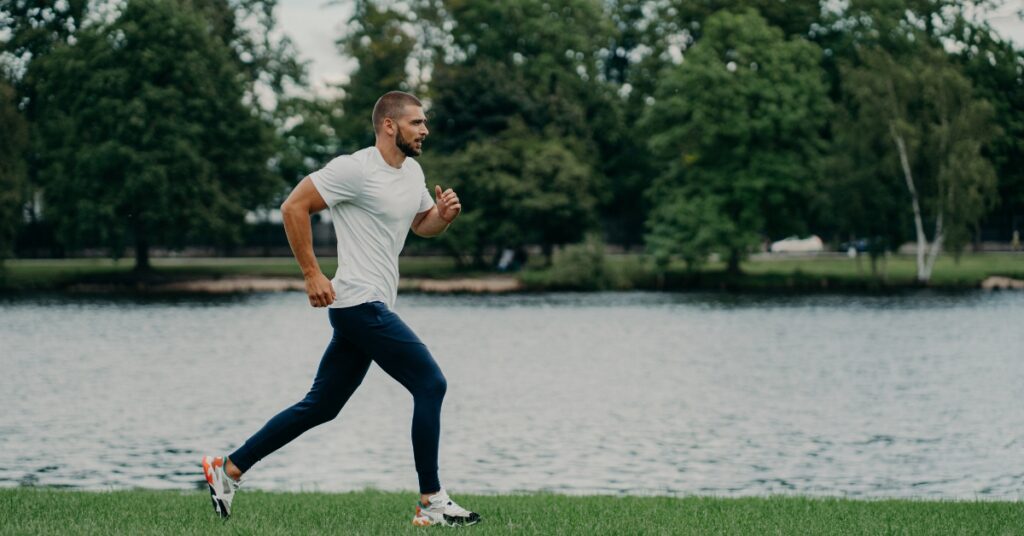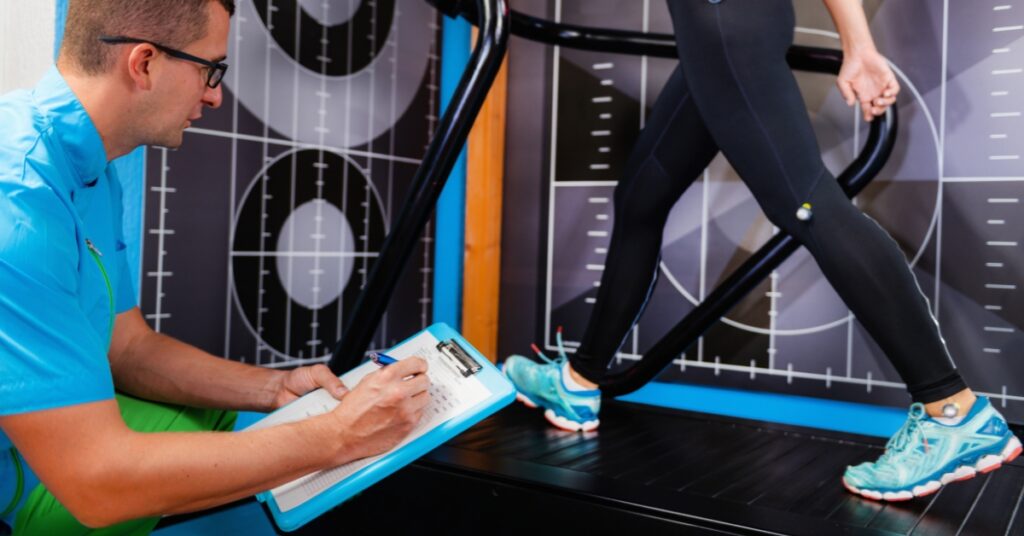Running faster feels exhilarating, doesn’t it? But the last thing you want is to push your limits and end up sidelined by an injury. Whether you’re training for a race or simply chasing a personal best, you need to know how to run faster without facing debilitating injuries.
You don’t have to sacrifice progress to protect your body.
By focusing on smarter training techniques and tuning into what your body needs, you can boost your performance without risking those nagging aches and pains.
Let’s talk about how you can do it.
Top 12 Tips to Run Faster AND Avoid Injuries
1- Strength Train To Build Power
Strength training is a game-changer for running speed and injury prevention. When you build stronger core muscles, leg strength, and upper body power, you enhance your overall running performance.
A study published in the International Journal of Environmental Research and Public Health examined the effects of different training modalities on recreational endurance runners. The findings revealed that runners who engaged in concurrent training—which combines running-specific strength training with endurance workouts—experienced significant improvements in body composition, strength, running economy, and aerobic capacity.
The study concluded that “concurrent training is an effective strategy to improve performance… parameters in recreational endurance runners.”
To get started, focus on exercises like squat jumps, lunges, and planks to build endurance and explosive power for faster speeds.
Include bodyweight exercises to improve stability and minimize wasted energy with each stride. A stronger body allows you to maintain good running form, even during hard efforts like speed work and hill training.

2- Analyze Your Running Gait
A proper gait analysis can make a significant difference in running performance and injury prevention.
Understanding your foot strikes, stride length, and overall running economy helps you run more efficiently.
Work with a physical therapy professional to assess your running form. Small adjustments, like improving your foot placement or reducing wasted energy, can lead to a faster pace and fewer injuries over longer distances.

3- Incorporate Speed Work Into Your Training
To run faster, you need to train faster. Interval training, tempo runs, and speed play are excellent running exercises to boost your running speed and overall speed.
Start with a manageable training schedule that includes both speed and recovery rest. Alternate between slower pace runs and hard efforts to build a sustainable pace while avoiding burnout.

4- Master Good Running Form
Maintaining good running form is essential for efficiency and injury prevention.
Keep your posture upright, your arms swinging naturally, and your strides quick and light.
Think about minimizing wasted energy with every step. Proper form keeps your muscles working efficiently and helps you run at a faster pace without overexerting.

5- Focus On Your Training Plan
A structured training program is key to balancing speed and injury prevention. Plan weekly mileage that gradually increases, and allow for enough rest between intense runs.
Include a mix of hill training, longer distances, and recovery rest days.
A good training plan helps you build running endurance while staying injury-free.
6- Fuel Your Body With A Balanced Diet
Your eating habits play a huge role in how well you perform during runs. Include healthy fats, lean protein, and complex carbohydrates to fuel your workouts and recover effectively.
Proper nutrition supports both speed and stamina, giving you more power during challenging runs and helping your muscles recover after hard efforts.

Prioritize Recovery And Rest Days
Recovery is just as important as running. Without enough rest, your muscles start to fatigue, increasing your risk of injury and slowing your progress.
Take at least one rest day per week to allow your body to heal and rebuild.
Recovery rest improves your overall running performance and ensures you’re ready for the next workout.
Ready to take your running to the next level? Schedule your FREE Discovery Call with Up and Running Physical Therapy, or call us now at (970) 500-3427.
With our expert run coaching, learn to run faster, stronger, and injury-free!
7- Train Your Mental Game
Running isn’t just physical; mental preparation is crucial for improving speed and endurance.
- Build mental toughness by setting achievable goals and focusing on maintaining a challenging but sustainable pace during workouts.
- Visualization techniques can help you stay confident and focused, especially on race day.
When your mind is strong, your body follows.

8- Movement And Physical Performance Testing
Improving your running speed starts with understanding how your body moves.
Movement and physical performance testing assesses your running form, flexibility, and strength to identify areas for improvement.
Addressing issues like inefficient foot strikes or weak core muscles can make a significant difference in both injury prevention and running economy.
By targeting specific imbalances, you can enhance your efficiency and power, making faster running and longer distances more achievable.
This foundational step is key to building a sustainable training plan.

9- Custom Training Plans For Faster Running
A well-designed training plan is essential to achieving a faster pace while minimizing injury risk.
Custom plans incorporate critical elements like interval training, tempo runs, and recovery rest, balancing hard efforts with smarter recovery to improve overall running performance.
Whether you’re preparing for a half marathon or just learning how to run more efficiently, a personalized approach ensures you’re building strength and endurance at a pace that works for you.
Tailoring your training plan to your goals helps you run faster without overtraining.
10- Professional Run Coaching For A Big Difference
Professional coaching offers you tailored advice on how to run faster and smarter. Working with a coach trained in injury prevention and efficient running form provides insights you might miss on your own.
A coach can guide you through speed training, hill training, and strength training to build power and endurance. This approach not only improves your running speed but also helps you stay consistent and injury-free over longer distances.
Investing in expert coaching can make a big difference in becoming a faster runner.
11- Add Hill Training To Build Strength
Hill training is a powerful way to improve speed and running efficiency.
Running uphill strengthens your legs, improves stride length, and builds running endurance.
Start with shorter hills and a comfortable pace, gradually increasing intensity as you gain strength.
This type of workout not only boosts your speed but also reduces the risk of injury.

12- Practice Tempo Runs For Running Economy
Tempo runs train your body to sustain faster speeds over longer periods.
These runs challenge your muscles and improve your overall running economy, making you a faster runner.
Run at a comfortably hard effort for a set distance or time. This approach helps you adapt to a faster running pace while avoiding overtraining.
13- Include Cross Training For Balance
Cross training, such as swimming, cycling, or yoga, complements your running program by working different muscles and giving your legs a break.
It’s an excellent way to build endurance and lose weight without putting extra stress on your joints.
Cross-training keeps your training schedule balanced and reduces your risk of overuse injuries.

14- Listen To Your Body
Above all, pay attention to how your body feels. If you notice discomfort or fatigue, adjust your training plan to allow for more recovery rest or slower pace runs.
Your running tips might work differently than someone else’s, so adapt based on what feels right.
A smart approach to training keeps you on track for injury-free progress.
15- Video Running Analysis For Efficient Running Form
A video running analysis can transform the way you approach your training.
By capturing your running form in detail, this tool helps you understand key factors like foot strikes, stride mechanics, and posture. Even small adjustments can lead to a big difference in running performance and injury prevention.
For example, improving your stride or balancing the effort between your legs can enhance your running economy and help you run faster with less wasted energy.
Whether your goal is to master hill training or recover after hard efforts, a video analysis provides actionable insights to refine your form and achieve faster running over time.

Up and Running Physical Therapy: Transform Your Running Performance
At Up and Running Physical Therapy in Fort Collins, CO, our run coaching goes beyond generic advice to deliver personalized plans that help you achieve faster running and better performance.
We provide the tools and support you need to succeed whether you’re striving to:
- Improve running speed
- Reduce injuries
- Prepare for a big race
Our focus is on efficient running form, injury prevention, and tailored strength training to address the unique challenges runners face.
Whether you’re tackling a half marathon or working on building endurance for longer distances, we ensure every step counts.
Maximize Speed With Tailored Training Plans
We design custom training plans based on your specific goals, fitness level, and schedule. These plans include essential elements like:
- Speed workouts and interval training to achieve faster running
- Recovery rest to build resilience and prevent overtraining
- Strength training to enhance running economy and minimize wasted energy
Our plans are dynamic, allowing you to progress steadily without unnecessary setbacks.

Gain Insights With Video Running Analysis
Understanding your running form and gait is critical to improving both speed and efficiency.
Through video running analysis, we evaluate your foot strikes, stride length, and posture to identify areas for improvement.
Even small adjustments in form can make a big difference in your overall running performance.
By refining your gait and minimizing wasted energy, we help you run faster with less effort.
Build Strength To Prevent Injuries
Strength training is a cornerstone of our coaching program. By focusing on exercises that target core muscles, leg strength, and stability, we help you develop a stronger foundation for efficient running form.
Our approach includes weightlifting and running-specific movements like squat jumps to boost your power and endurance.
This combination prepares you to tackle challenging runs and longer distances with confidence.

Expert Coaching And Support
Our professional run coaching offers personalized guidance every step of the way. We help you learn how to run smarter, push through hard efforts, and optimize your training plan.
Whether you’re a beginner or a seasoned marathoner, our program empowers you to break through barriers and achieve faster speeds safely.
With our expertise, you can focus on reaching your goals while minimizing the risk of injury.
Start Your Journey Today
Ready to take your running to the next level? Schedule your FREE Discovery Call with Up and Running Physical Therapy, or call us now at (970) 500-3427.
Let’s work together to help you run faster, stronger, and injury-free.

